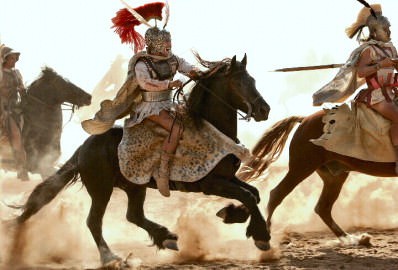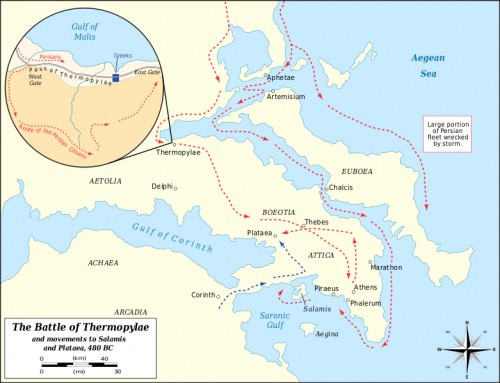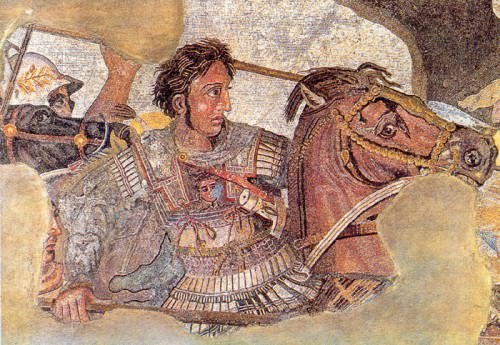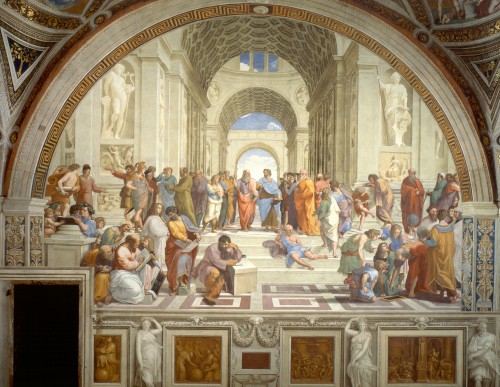Ancient Greece has been represented in cinema several times over the years and has received mixed reviews, unfortunately primarily negative. The genre appears to have fallen behind the dark shadow of Rome and perhaps with good reason. Despite any failures that filmmakers have made along the way, films based in antiquity continue to be popular for they possess the ability to bridge the gap between the past and the present, offering spectacular and compelling interpretations of history that are both relevant and educational for viewers. This can be said for both Greek and Roman history, yet what is it about Greek history that seems so difficult to portray on screen? Evidently, there are three primary issues in regards to filming Greek history in a manner that modern audiences will be able to both understand and connect with: the problem with “Greek love;” the lack of unity within ancient Greece; and the difficulty of filming key “Greek” ideas. The famous tales of the battle of Thermopylae and Alexander the Great have emerged as the most “successful” Greek stories to be represented in film, however, they are not without fault. By examining how filmmakers have addressed the issues of representing Greek history through films such as Alexander the Great (1956), Alexander (2004), The 300 Spartans (1962), and 300 (2007) the success and failure of each will be identified as well as how such films may mark a shift in this trend of unpopularity.
ISSUES WITH “GREEK LOVE”
What has become one of the most notorious aspects of ancient Greek culture is also one of the main issues when representing Greek history on screen. This aspect is, of course, the idea of “Greek love,” and it has come to be a very uncomfortable theme within the modern world, often dismissed repeatedly as outrageous and/or disgusting. Interestingly enough, not only does modern society take issue with the idea of Greek love, it is also uncomfortable with the idea of nudity during athletics. This is extremely obvious when watching any Greek historical film, for individuals represented exercising are always depicted in loincloths rather than in the nude. Take300 or Alexander for example, where king Leonidas wrestles with his son, and young Alexander with his companions under the tutelage of their instructor. Clearly, depicting actors in the traditional nude would be too much for a modern audience to handle, and if that is deemed inappropriate, then how could “Greek love” be represented?

An artistic impression of Alexander the Great in combat (played by Colin Farrell), from the motion picture Alexander (2004), directed by Oliver Stone. Photo by Warner Brothers.
The films based on Alexander the Great are excellent examples of the unease experienced by audiences when representing Greek love. Perhaps unsurprisingly, Alexander’s “pan-sexuality” has been blamed for the topics lack of success in film. Alexander had various romances throughout his life, and to represent them all within approximately two hours would no doubt confuse the audience. As a result, filmmakers have chosen to fixate on specific relationships, primarily Hephaestion and Roxane. Unfortunately, the relationship with Hephaestion has proven to be too much for the audience to handle once again, and director of Alexander the Great, Robert Rossen, chose to practically remove Hephaestion from the plot entirely leaving him present but otherwise pointless. In contrast, Oliver Stone, director of Alexander, not only included Hephaestion in the narrative, but also chose to include the strong romantic relationship between the two men. This shift can be attributed to the movement of ideas within the United States, and also on an international level, in regards to homoerotics and homosexuality on screen. This trend was also reflected in the film, Brokeback Mountain (2005) that was highly celebrated by critics and moviegoers alike. Since then, films and television shows have pushed the limits of male nudity and homosexuality, as seen in television shows such as True Blood and the film Shame (2011). Perhaps Greek love will one day be accepted as well, but until this shift towards acceptance comes to pass, the idea of Greek love remains unloved by the audiences.
In order to combat this issue, filmmakers have generally resolved to making strong heterosexual statements instead. This has further implied that heterosexuality is the only acceptable identification that is natural or universal. It appears that any examples that deviate from this theme may even be considered a threat to normal values, or perhaps even a threat to the family or social system itself. Examine 300 for example, the Spartans are meant to portray the ultimate heterosexual masculine model by contrasting themselves to Athenians refereed to as “boy lovers.” This is somewhat amusing considering the Spartans would have also participated in pederasty; however, this is over looked. Not only that, but the romance between Leonidas and his wife, Gorgo, has been included for both the popular desire for a love interest, as well as a strong representation of the “proper” model of love, as their son represents the “proper” result. 300 has been labeled as borderline homoerotic porn, yet with such inclusions the filmmakers are still trying to steer towards the acceptable model of sexuality.
GEOGRAPHICALLY AND ADMINISTRATIVELY PROBLEMATIC
Less controversial, yet just as problematic for filmmaking, ancient Greece was not unified in terms of geography or politics. Mountains, waterways, and islands form the region making political alliances somewhat inconvenient. Aside from the obvious issue with geography, there was never any sense of “Greece” as a country in the ancient world. Instead, Greece was made up of many city-states, or poleis, each independent from one other and possessing distinct ethnicities. This formation creates the concept of isolation that has discouraged interested filmmakers, and with good reason. When asked what comes to mind when one thinks of Greece, modern audiences will likely describe Athens. Unfortunately for the world of cinema, Athens was not an iconic center as Rome was. In addition to that, most individuals of today do not know what Athens looked like in ancient times, leaving filmmakers struggling with how to depict Greece on screen. This puzzle can be examined through the setting of Atlas (1960), directed and produced by Roger Corman. Atlas was actually filmed in Greece, using ruins as sets. Alas, for the film, the Greek motifs were used awkwardly and failed to create a distinctive visual image of Greece. As a result, Roman themes filtered in in an attempt to fill the void, as was done in other Greek historical films such as The Colossus of Rhodes (1961) with soldiers of Rhodes wearing bright red cloaks reminiscent of Roman legionnaires. Seemingly doomed to fail, it is difficult to film something that the audience will not be able to identify, and even more difficult to create something that did not exist at all, such as a unified Greece.

A map indicating the location and military positions taken in the Battle of Thermopylae in 480 BCE between the Persian invading forces of Xerxes I against a small Greek force led by Spartan king Leonidas. Defending the pass for three days, the Greek force was ultimately defeated. Photo by Dept. of History, US Military Academy.
In an attempt to overcome the latter, filmmakers have often chosen to focus on the battle of Thermopylae, an historical moment in which Greece banded together against Persian Invaders. Taking place in 480 BCE, this battle has been remembered in history as a defining moment of the Persian Wars. Films have chosen to focus on Thermopylae itself rather than the war over all, likely due to the notorious reputation of the battle throughout the ages as the “Greek Alamo”. This battle has been remembered in history as an example of fighting for freedom against all odds. Even though the Spartans and their allies were grossly outnumbered, they were able to make a stand against the Persians. And despite their loss, they played a significant part in winning the war. Regrettably, even this courageous moment in Greek history has fallen victim to the issues that plague Greek historical films, not least of all visually representing the region in a successful manner.
Luckily for 300, the film does not even pretend to be historically accurate. If filmmakers had described it as such, no doubt classicists would have swarmed the film with even more bad reviews and critiques. Nonetheless, the viewer would do well to remember that the film made no attempt to explain the complex issues faced by the Greek poleis when faced with the Persian invasion. As mentioned previously, since there was no sense of a unified Greece, the act of banding together would have been a daunting task for the Greeks and a difficult concept to explain to a modern audience within the time frame of a film. 300 avoids this issue by removing itself from the war almost entirely, fixating on the Spartan perspective as the main protagonists for the whole battle. Sure, this makes for an interesting and clear storyline, yet once again the sense of a unified Greece is lost in the process. Even an iconic moment in history such as Thermopylae is not immune to the issues of Greek historical film, and evidently neither is the great Alexander of Macedon.

Detail of the Alexander Mosaic, representing Alexander the Great on his horse Bucephalus, during the battle of Issus. Photo by Ruthven.
Since antiquity Alexander the Great has been admired and viewed with a sense of reverence. In light of this, Alexander appears to be the perfect candidate for a film adaptation, a ready-made storyline, the embodiment of past greatness for the Greeks, and an inspiration for European imperialist enterprises. It is under the reign of Alexander, and before him his father Philip II, that Greece was finally unified under a single reign, marking him as a possible solution for the issue that is Greek historical film. Unfortunately, the true Alexander is difficult to distinguish as ancient sources are fragmented, and various interpretations have developed over time. The result of this being that any attempt to film his life would end in an attempt to define it. By defining Alexander, filmmakers face a great issue in that there will always be those who disagree and disapprove of the film. Once again, even the greatest of legends cannot be translated into film quite as easily as expected.
WHAT TO FILM, WHAT TO FILM…

The famous ‘School of Athens by Raphael, painted between 1510-1511 CE, depicting all of the major philosophers of antiquity with Plato and Aristotle at the centre. (Vatican Museums, Rome). Photo by Raphael.
Aside from the great tales of Thermopylae and Alexander, what else is there that comes to mind when one thinks about ancient Greece? There is Athens of course, with the Parthenon, yet how can a filmmaker develop a plot around such a vague subject matter? Herein lies the final, and perhaps the most obvious, issue in regards to Greek historical films. When most individuals are asked to describe the first things they think of when they imagine Greece, they will list the Parthenon, philosophy, and democracy. Of course all of these subjects were highly influential and valuable within the ancient world and are still valued today, however, they are not overly fascinating to modern audiences on their own. Athens is generally viewed as an ancient university as the great thinkers of the ancient world flocked to Athens, including Roman emperors. Yet how can filmmakers make a movie about an ancient university, a place of ideas and therefore essentially “boring” to most audiences? Here is the ultimate issue in regards to filming Greek history: the great fear that the ancient Greeks will bore the audience. Greece appears to lack the “eye-candy” of Rome with its gladiators, assassinations, and great battles pitched again distant barbarians. The most disappointing aspect of the entire situation is that over half of Roman culture was Greek to begin with, and most of the audiences watching such films do not even realize it. Greece has fallen into the shadow of Rome, almost forgotten behind a series of films that have failed to capture its essence.
As Greek history lacks the necessary idea of unity and the broad frame of reference possessed by Roman history, Greek historical film has repeatedly resorted to the use of Roman references in order to create a sense of antiquity. In so doing, filmmakers have created a subconscious reference for the audience to realize that what they are watching is based in the ancient Mediterranean world. Such references may include the use of Latin letters as seen in Atlas within a Roman amphitheater, the use of Roman costumes, Roman art and architecture, and even Roman references within military exploits such as the Greek invasion in Troy. Regrettably, by doing so filmmakers have jeopardized any sense of “Greekness” that the film initially possessed.
Next to the main issues with representing Greek history in film, the eligible storylines are far too complicated to be compressed into a tolerable length of time. The end result of such attempts includes oversimplified plots as seen within The 300 Spartans and 300 in which the relations between Athens and Sparta have been simplified to the point where Sparta alone seems to take on Persia. All of this is done in order to not only fit the story into a single film, but also to create a sense of unity among the Greeks to make the plot more comfortable for the audience. Also, the film adaptations of the battle of Thermopylae focus on the battle alone rather than describing the war and events leading up to the event. The audience is forced to take the film at face value, trusting that what they are watching to be true. Despite the fact that these films have not claimed to be historically accurate, the audience must remember that they are only representations and interpretations of events seen through the lens of the modern world, and they should be viewed as such.
CONCLUSION
Many great men and women have looked back to the Classical world for authority and inspiration, the modern medium of film is no different. The popularity of films set within antiquity have risen and fallen over the years, yet Greek history continues to fall short in comparison to Rome. Rome represents a fascination with images of war, violence, and even death, all of which can be effectively portrayed in cinema and have continued to draw the crowds. Unluckily for Greek historical film, while tales of violence radiate from Rome, tales of democracy, art and philosophy flourish in Greek history. Granted, these are all very admirable qualities, but they do no make for very appealing films. Overall, Greece appears to have received the short end of the stick in terms of popularity within the modern world.
Unlike the expansive repertoire of Roman history, only two instances of Greek history appear to be suitable for film, namely the tale of Thermopylae and Alexander the Great, both of which have proven to have their own difficulties when it comes to cinema. Sadly for Greek history, it appears that the modern world is simply not ready for representations of true Greek identity, such as “Greek love”, or male nudes in general. This idea is changing in popular culture, and perhaps one-day filmmakers will be able to depict this aspect of the Greek world. Until then, Greek historical films must continue to avoid this aspect as they have done for decades. Although the issue of “Greek love” may change, the concept of unified ancient Greece will never exist except for in ones imagination. This is a concept that will haunt prospective filmmakers until the end of time, for it is impossible to film something that has never existed and it is just as difficult to create a storyline that the audience cannot understand or resonate with. Such is the unfortunate fate for Greek history in film, with so much to offer in regards to culture and success, yet ultimately undesirable in cinema.